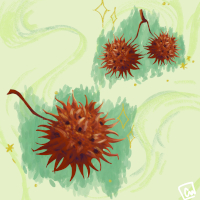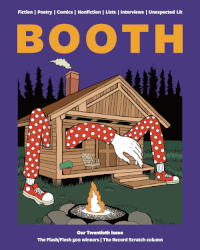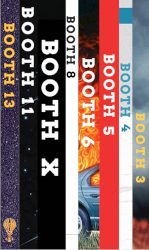by Alex Mattingly
Lethem recently spoke at Butler University as part of the Vivian S. Delbrook Visiting Writers series, after which he sat down to speak with Booth's Alex Mattingly.
Alex Mattingly: When you were starting out, looking for places to publish, did you have an idea of what kind of writer you wanted to be?
Jonathan Lethem: I did, but that idea changed constantly based on something new I’d learn about myself from writing, or something new I’d glimpse about the world of publishing. So yes, I had what I felt was a strong idea, but it was a very mercurial one at the same time. What I really had was a strong impulse to assume the role of the writer in some way, and I was waiting for the world to say yes to that.
When my first novel was published, it was a bit of a Rorschach test. Some people thought it was a postmodern pastiche, some people thought it was an out-and-out dystopian novel, and some people were sure it was a crime novel, because it introduced a detective and because there were clues in the book and a solution at the end, They were sure I was going to write about that detective over and over again. So I got in this business of gratifying and also disappointing expectations very early on.
It was great fun to try on these different roles. For me, it was exciting to keep messing with expectations. I like being slippery and problematic.
AM: Amnesia Moon, your second novel, which was sort of a strange collection of dystopian fantasies, was very different from Gun, With Occasional Music. I read somewhere that it actually began from several short stories you’d written.
JL: It was partly a salvage operation. I had these failed short stories that began to relate themselves in my mind. They all exhibited these same impulses – I felt compelled to destroy the world again and again. I started to wonder, what am I trying to accomplish here? Why do I want to imagine everything in ruins? And I thought that maybe these unfulfilled apocalyptic stories could themselves be put in relation to one another, where the question that was interesting to me was, why do I keep doing this?
It was about characters who are dreaming the world into destruction, and why they feel they have to do that. It’s a very homely construction, and I wonder sometimes how it would strike me if I reread it. Some of my earliest published writing ended up engulfed in that book – there’s stuff written by an eighteen year old in there. The fact that it’s still in print and sitting among my other books is almost an act of impersonation. It’s like a kid in a Halloween costume. On stilts.
AM: You’ve described Chronic City as a dystopian novel as well.
JL: It’s the kind of book I was trying to write when I wrote Amnesia Moon, but which I didn’t have any of the equipment to do. It’s the kind of book I once thought I would always be writing, consisting of characters enmeshed in reality meltdowns and paranoid deconstructions of everyday life. I loved that so much when I first encountered writers doing it, I valorized it so totally that my dream was to be that kind of writer exclusively. Of course, I turned out to have all sorts of other agendas that snuck up on me, but in Chronic City it’s like I got back to the primary job, my initial assignment.
AM: Do you see any of that with the book you’re working on now? You’ve described it as being set against the collapse of the ideals of Communism, and it seems that the characters must be dealing with their own private dystopias.
JL: It’s there but in a totally different kind of way in my thinking about the real life political nightmare of the American Left in the twentieth-century, which is a kind of paranoid dystopia that was enacted. Half the communist cells in America consisted of three real communists and two FBI agents leading the charge. Half the communist activity that was detectable in America, at a certain point, was probably created by FBI agents. It is its own insane game of masquerade and paranoia, but also with this unbelievably powerful core of human learning and despair of wanting to transform the world and having that spirit crushed so utterly in so many ways.
It’s not so different, but it’s sourced in personal memory for me and in factual research into the era, the fifties and sixties. But in a certain way, helplessly, it’s the same kind of project again.
AM: Can you talk about your approach for a collaborative piece like Omega the Unknown, or the book with Carter Schultz, Kafka Americana?
JL: With both those projects, the conditions of their creation were so specific . . . with Carter, we had been thinking and talking about this joke that became much more than a joke, that there was something about Franz Kafka and Frank Capra, apart from their names, that was in dialogue and needed to be unearthed. So we drew this idea out of the air between us, and if we were going to do it justice it would have to be a piece of genuine collaborative writing. Of course, it also had a reflexivity in it, because it was a collaboration about the idea of collaboration between two sensibilities. We were two writers with different strengths and different leanings, writing about two artists with different strengths and different leanings. The hope was that maybe we could be the antidote to the other’s weaknesses rather than cancelling out each other’s strengths. But I just can’t imagine those exact circumstances coming about around any other thing.
Omega the Unknown was collaborative too, but in some ways much more awkward and in slow motion. It was actually an involuntary collaboration, imposed on the other creator, Steve Gerber. It also came at a time when I was thinking a lot about intertextuality and multiple-authored works, and how, while the art form I’d chosen didn’t have a particularly strong tradition of collaboration, there were other art forms like pop music or Hollywood film or the superhero comic book that were fundamentally collaborative. So I was excited about that. I wanted to see if I could enter into this position, be the writer of a comic book who could never claim for a minute that everything on the page was my responsibility or origination, and instead celebrate this weird, bastard form.
AM: Did you approach Marvel with an interest in the character, or did they approach you?
JL: They invited me to do something with some character of theirs. I think they were expecting me to pick Spider-Man or somebody famous, the idea being that anyone given the keys to the castle of their intellectual property would want to choose one of these mighty pieces of property. But instead it was like I came in and ignored all the treasure and instead noticed this ashtray that someone’s twelve-year-old made in school and said, “I want that!” One of the guys I talked to in the initial meeting didn’t even remember the character.
AM: Were you into this character as a kid?
JL: I loved him as a kid, and I’d always fantasized about what the story might have become if he’d been popular enough to be continued. There’s a certain beauty in ruins, and Omega the Unknown was a ruined story. It only existed for ten issues, and even those had been compromised – the first writer, Gerber, had been taken off the book for a couple of issues. So it was a fragment, and I began to imagine what the fragment would look like if it were completed.
AM: Gerber was pretty unusual for his time – he created Howard the Duck, for instance.
JL: He was a very strange writer, and very much ahead of his time for comic books. He was doing stuff that anticipated the graphic novel boom, things like Watchmen or The Dark Knight Returns, these literary retellings of superhero myths. He was doing that before anyone had any idea that there was an audience for that, or could even understand what he was up to. He was twenty years ahead of his time, at least.
AM: With Omega the Unknown, were there issues on the shelf while you were still writing it, or did you have it pretty well scripted out in advance?
JL: I wanted to understand what I was doing, and get command of it before I let the first issue get out. What I did was a ten-issue sequence, and in fact there were issues published before I’d written the last issue, but I’d gotten a grip on the thing. I wasn’t working as much by the seat of my pants as a “real” comic-book writer would have been. I was working so much slower, it was humiliating when I think about it. Those guys were writing seven of those comic books a month in their heyday, and I was taking three or four months over each issue. Marvel must have thought they had the most astonishing prima donna on their hands.
AM: Did you work from an outline with something like that?
JL: I never like to work from outlines. Sometimes I resort to it, in certain situations, most often when someone needs evidence of the fact I know what I’m doing, and then I’ll sometimes grudgingly scrape out a few pages of plans. But in this case, I did it from my own sense of security. I didn't do heavy outlining, but very scant indications, just so I could trust that I was going somewhere.
AM: With a book like Motherless Brooklyn or Gun, With Occasional Music, where the mystery element is so strong and there have to be clues along the way, would you use an outline in that case, or do you feel your way along more intuitively?
JL: I was very audacious about working without plans. With the two crime stories, I had to have a solution in mind, and feel my way towards this revelation. There’s one part of your brain that’s working backwards when you try to write a crime story with any kind of traditional resolution, and each of those does have a version of that. They’re trick resolutions, but that’s actually traditional in most cases. So I had to consciously plot backwards from a solution, but I didn’t do that with a lot of notecards or charts or diagrams. As it happened I did it all in my head.
AM: Who are you reading now?
JL: There’s a core group of names that I’ve dropped so often it would probably be humiliating to me if you Googled and revealed it, but they’re my constellation of formative influences, so I do think about them all the time, helplessly. They help organize the way I think about storytelling, and even more than storytelling they’ve laid down track in my brain for how I think about experience, consciousness. Kafka, Orwell, Philip K. Dick, Shirley Jackson, and so on. And then I expanded, and started piling other kinds of influence on top of that.
And some of those layers are very formative too, such as when I discovered Italo Calvino, or Don DeLillo in my early twenties. Anything subsequent to that can be wildly exciting, but I’m not eligible to be reprogrammed. No influence will ever compare quite to some of those.
But in recent years I’ve been consciously in the thrall of Iris Murdoch, Christina Stead, Philip Roth, James Salter, J. G. Ballard, all at different times and sometimes in different combinations. Those are the writers that are prominent enough in my mind I would never be surprised if someone pointed them out. And then there are others that I’m conscious of, but wouldn’t be obvious to other people. Some of them are very foundational writers – I was reading a lot of Henry James in the years up to the writing of Chronic City, and I don’t think anyone would call it Jamesian. But I was absorbing a lot of his version of social arrangements in fiction, and I can see imprinting itself on the results of the book I was writing. Similarly, Charles Dickens is in Fortress of Solitude, but there’d be no reason for anyone to remark on it. Partly because Dickens is such a fundamental influence on fiction per se that to be influenced by him is just to say you’re a novelist. Whether you read Dickens or not, he’s part of what you do. He’s part of the basic language.
AM: What’s your actual process like? When you sit down at the computer, or the writing desk, what happens next?
JL: Well the answer’s pretty much in the question – I sit down at the computer, I sit down at the writing desk. The only rule I keep is to work every day, because I strongly believe in the power of remaining subconsciously immersed in the work. The same thing that makes writers problematic spouses, that they’re always a little bit thinking about their project, is to me impossible not to desire. I want to always be half-writing as I fall asleep and as I wake up. Because then I work better – I stay attached to the work. I’m not a very fast writer, but I’m committed to the idea of putting together a shelf of books. I’ve always believed that the writers I’ve loved most, it’s not that they were prolific or speed-demons, but they kept at it and rewarded their readers' curiosity with a lot to read and explore. I’d always be very frustrated when I found a writer I loved and then found out they’d only written one other book. I’ve always wanted to be able to delve and consume, and so I want to be able to offer that.
The way to write a lot, if you’re not fast, is to write every day, to be the tortoise and not the hare. I’ve tried to do that faithfully, to trudge every day through some paragraphs. For me, a good day is a page and a half of fiction. Once in a while I’ll get on a tear and leave three or four pages behind, but I don’t rely on that by any means. I’m happy if I get my page or two.



